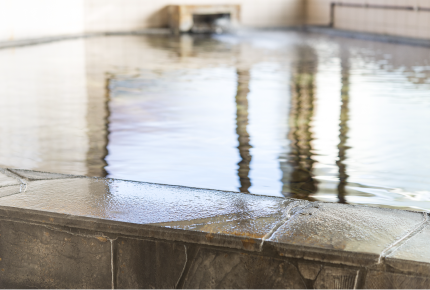Bathing section

- Become healthy in a large bath.
- The reason a larger bath feels good is that there is a difference in mental waves. Negatively charged ions in the bath restore cells and feels good so it improves health.
- Bath variety
- There is a large variety of bathing facilities such as bubble bath, ultrasonic bath, streaming bath, wind bath, radon bath, sitting bath, laying bath, electric bath, wave bath, carbonated spring, black bath, and medicinal bath.
Also, strong jacuzzi jets have been found to prevent and reverse dementia.
- Body warming effect
- Sento water temperature is usually above 42℃, and some baths advertise temperatures above 45℃. At home some people enjoy going halfway in, but the smaller tub may lose temperature and your body may not become warm. Sentos have larger bathing rooms, and water temperature is constantly maintained and the room is filled with steam, so going halfway in will still be satisfying.
- Community space
- Sento is a place to bathe with many other people. For people who are lacking in everyday interaction, it soothes loneliness and provides emotional stimulation. Positive mental stimulation is connected to better physical health.
Also, there is a smaller chance of an accident when people are watching. Nationally, the number of elderly bathing accident deaths is 14,000(Tokyo Emergency Medical Service Association)
This is almost all from home baths. The chance of these unfortunate accidents happening can be reduced by going to sento.
History
- Sentos started with temples.
- Temple builders have believed that cleanliness is important for any Buddhist, and have usually built a bath building within temple grounds, which led to bathing being appreciated by the common people. Then around 1000 years ago, citizens gradually learned the enjoyment of bathing and built bathhouses in Kyoto, the predecessors of sento.
- Bathtubs grew in the Edo period
- In the Edo period, many different bathing facilities were built. Sentos in the Edo periods started as steam baths.
They were closet shaped baths where enough water to cover the knees was poured in, then the lower body was submerged, then the upper body was steamed.
By the end of the period, regular baths were built in which people can be immersed up to the neck.Popularization among common people.
In the Edo period, a method of inserting a fire-heated iron cylinder inside a wooden tub was invented and it was called a Teppo bath. In the Kansai region, the more popular form was a Goemon bath where water is heated from the metal on the bottom of the bathtub.
- Sanitation improvements
- In the Meiji period, there was a change in sento construction.
Lowered entryways were removed, ventilation was built into roofs, baths became flat, and the size of the washing area was incresed.
These became known as improved baths, and were popular. They later raised bath walls and made barriers to prevent dirt from getting in.
In the Taisho period, sentos were even more modernized when tile baths replaced wooden baths.
Around 1927, faucets were installed for both cold and hot water, further improving sanitation.
